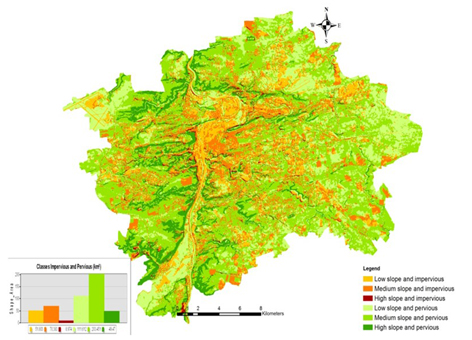
The Relationship Between Green Areas and Slope: Case Study the City of Prague
Abstract
This paper focuses on the case study of Prague, the capital the Czech Republic with the aim of identify and analyzing the urban green areas. The paper study the relationship between impervious (built areas) and pervious areas (green areas) with topographical features in the city. The methodology applied was NDVI (Normalized Difference Vegetation Index) index using the Sentinel-2 image (10 meters resolution) with free access to data. After this initial filtering, was analyze the correlation between pervious and impervious areas with slope conditions using as method the combinatorial analysis to produce the maps describing the relationship between green areas and percentage of slopes. The resulting maps indicate a correlation between land use, green areas, and topography.
Keywords
Full Text:
PDFReferences
Alberti, M. (2005). The effects of urban pattern on ecosystem function. International Regional Science Review, 28 (2), 168-192.
Andersson, E., Barthel, S., Borgström, S. & Colding, J. (2014). Reconnecting Cities to the Biosphere: Stewardship of Green Infrastructure and Urban Ecosystem Services. AMBIO, 43, 445-453.
Breuste,J., Niemela, J. & Snep, R. (2008). Applying landscape ecological principles in urban environments. Landscape Ecology, 23, 1139–1142.
CORPENICUS MISSION. Website: http://www.esa.int/Our_Activities/Observing_the_Earth/Copernicus/Overview4. Access: 05/06/2017.
EUROPEAN COMMISSION. (2013). Building a Green infrastructure for Europe. Cataloguing data. European Union.
Forman, R.T.T. & Godron, M. (1986). Landscape ecology. John Wiley & Sons, New York.
Forman, R. (2002). The missing catalyst: design and planning with ecology roots. Editors Bart Johnson and Kristina Hill. Ecology and Design: Frameworks for Learning. Island Press.
Freire, N. C. F. & Pacheco, A. P. (1994). Aspectos da detecção de áreas de risco à desertificação na região de Xingó. XII. Paper presented at Simpósio Brasileiro de Sensoriamento Remoto. Anais, INPE, Brasil.
Goddard, M.A., Dougill A.J. & Benton, T.G. (2010). Scaling up from gardens: biodiversity conservation in urban environments. Trends Ecol Evol, 25, 90–98.
Görner, T. & Kosejk, J. (2011). Territorial system of ecological stability (TSES) in the Czech Republic. Agency for Nature Conservation and Landscape Protection of the Czech Republic. www.gdos.gov.pl.
Groenwald, C. L., Oliveira, N. Z., Homa, L. & Ryokiti, A. I. (2009). Didactic Sequence with Combinatory Analysis according to the SCORM Standard. Bolema, 22(34), 27-56.
Hergoz, C. P. (2013). Cidades: (re) aprendendo a conviver com a natureza. Rio de Janeiro, Maud X: Inverde.
Nowak, D.J., (1993). Atmospheric carbon reduction by urban trees. Journal of Environmental Management, 37, 207−217
Oke, T.R. (1989). The micrometeorology of the urban forest. Philos. Trans. R. Soc. Lond., 324(1223), 335−348.
Pauleit, S. & Kaliszuk, E. (2005). An ecological approach to green structure planning: Green structure patterns. COST Action C11, Final report, European Commission, http://www.greenstructureplanning.eu/COSTC11-book/index.htm (accessed 1 December 2009).
Myneni, R.B., Hall, F.G., Sellers, P.J. & Marshak, A.L. (1995). The interpretation of spectral vegetation indexes. IEEE Transactions on Geoscience and Remote Sensing, 33, 481-486.
Rocha, N. A., Sena, I. S., Fonseca, B. M. & Moura, A. C. M. (2016). Association between a spectral index and a landscape index for mapping and analysis of urban vegetation cover. In: 9th International Conference on Innovation in Urban and Regional Planning e-agorà/e-ἀγορά for the transition toward resilient communities, Torino.
Rocha, N. A., Sena, I. S., Casagrande, P.B., Magalhães, M. C., Fonseca, B. M. & Moura, A. C. M. (2017). Studies of volumetric relation between vegetation and buildings using LIDAR data and NDVI to propose urban parameters. Revista Brasileira de Cartografia, 69(8), 1456-1475.
Rottenbacher, C. & Cassidy, T. (2014). Identifying Cultural Ecosystem Services of Urban Green Infrastructure Report about a pilot project undertaken in Lower Austria. REAL CORP, Vienna.
Rouse, J.W., Haas, R.H. And Schell, J.A. & Deering, D.W. (1973). Monitoring vegetation systems in the Great Plains with ERTS. Third Symposium of ERTS, Greenbelt, Maryland, USA. NASA SP-351 (1), 309-317.
Seitz, J. & Escobedo, F., (2008). Urban forests in Florida: trees control stormwater runoff and improve water quality. School of Forest Resources and Conservation Department, University of Florida. http://edis.ifas.ufl.edu (accessed 1 December 2009).
Swanwick, C., Dunnett, N. & Woolley, H., (2003): Nature, role and value of green space in towns and cities: an overview. Built Environment, 29(2), 94−106
Vasconcellos, A. A. 2015. Infraestrutura verde aplicada ao planejamento da ocupação urbana. Curitiba: Appri.
Refbacks
- There are currently no refbacks.
Copyright (c) 2018 Nicole Andrade da Rocha, Henry W. A. Hansov IV, Peter Kumble, Jenan Hussein, Ana Clara Mourão Moura
DISEGNARECON
ISSN 1828 5961
Registration at L'Aquila Law Court no 3/15 on 29th June, 2015.
Indexed in SCOPUS. Diamond Open Access. All papers are subjected to double blind peer review system by qualified reviewers.
Journal founded by Roberto Mingucci
